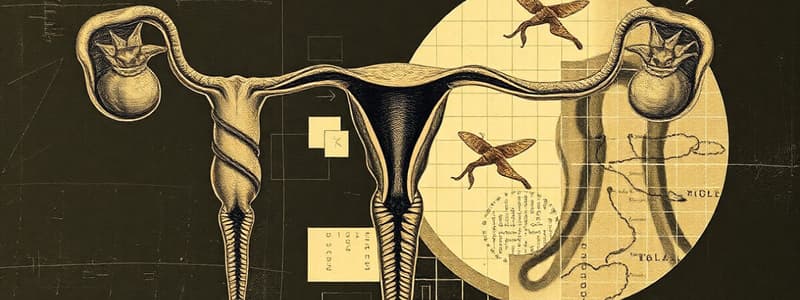Podcast
Questions and Answers
What is the main purpose of gamete production in the reproductive system?
What is the main purpose of gamete production in the reproductive system?
- Generate immune responses
- Facilitate nutrient absorption
- Ensure species survival through reproduction (correct)
- Regulate hormone secretion
- Produce new tissues
How does the male reproductive system support fertilization?
How does the male reproductive system support fertilization?
- By producing hormones necessary for implantation
- By producing oocytes for fertilization
- By creating zygotes independently
- By nourishing sperm cells until they mature and depositing them in the female reproductive tract (correct)
- By enhancing nutrient exchange between gametes
What is the role of the female reproductive system in nurturing a new individual?
What is the role of the female reproductive system in nurturing a new individual?
- Supporting fertilization at the uterine tube
- Providing hormonal support during development
- Nurturing the individual in the uterus until birth and providing milk afterward (correct)
- Producing sperm for fertilization
- Protecting gametes during meiosis
Which of the following hormones is NOT produced by the reproductive system?
Which of the following hormones is NOT produced by the reproductive system?
What is the main event during Prophase I of meiosis?
What is the main event during Prophase I of meiosis?
What process occurs during Metaphase I of meiosis?
What process occurs during Metaphase I of meiosis?
During Anaphase I, what separates and moves to opposite poles?
During Anaphase I, what separates and moves to opposite poles?
What is the result of Telophase I and cytokinesis in meiosis?
What is the result of Telophase I and cytokinesis in meiosis?
How does Metaphase II differ from Metaphase I?
How does Metaphase II differ from Metaphase I?
Why is the reduction of diploid cells to haploid gametes essential?
Why is the reduction of diploid cells to haploid gametes essential?
What is the chromosome count in a diploid human cell?
What is the chromosome count in a diploid human cell?
How many chromosomes are present in a haploid human gamete?
How many chromosomes are present in a haploid human gamete?
Which structure is a pair of homologous chromosomes?
Which structure is a pair of homologous chromosomes?
When does crossing over occur during meiosis?
When does crossing over occur during meiosis?
What is the significance of crossing over?
What is the significance of crossing over?
What are sister chromatids?
What are sister chromatids?
Which of the following describes homologous pairs?
Which of the following describes homologous pairs?
What is a key advantage of meiosis over mitosis?
What is a key advantage of meiosis over mitosis?
What process ensures genetic variation during meiosis?
What process ensures genetic variation during meiosis?
Why is meiosis necessary for gamete production?
Why is meiosis necessary for gamete production?
How does meiosis contribute to evolution?
How does meiosis contribute to evolution?
What distinguishes Anaphase I from Anaphase II?
What distinguishes Anaphase I from Anaphase II?
What phase directly precedes the formation of four haploid gametes?
What phase directly precedes the formation of four haploid gametes?
What happens to homologous chromosomes during Metaphase I?
What happens to homologous chromosomes during Metaphase I?
What is the ploidy of cells produced after Telophase I?
What is the ploidy of cells produced after Telophase I?
What role does independent assortment play in meiosis?
What role does independent assortment play in meiosis?
How many chromosomes are present in a human zygote?
How many chromosomes are present in a human zygote?
Which of the following occurs only in meiosis and not mitosis?
Which of the following occurs only in meiosis and not mitosis?
Which structure is formed by homologous chromosomes during Prophase I?
Which structure is formed by homologous chromosomes during Prophase I?
What is the purpose of meiosis II in gamete formation?
What is the purpose of meiosis II in gamete formation?
Flashcards
Gamete Production Purpose
Gamete Production Purpose
Gamete production ensures species survival through reproduction.
Male Reproductive System Function
Male Reproductive System Function
Supports fertilization by nourishing sperm and depositing them in the female tract.
Female Reproductive System Function
Female Reproductive System Function
Nurturing the individual in the uterus until birth and provides milk afterward.
Non-Reproductive Hormone
Non-Reproductive Hormone
Signup and view all the flashcards
Prophase I Event
Prophase I Event
Signup and view all the flashcards
Metaphase I Process
Metaphase I Process
Signup and view all the flashcards
Anaphase I Separation
Anaphase I Separation
Signup and view all the flashcards
Telophase I Result
Telophase I Result
Signup and view all the flashcards
Metaphase II Difference
Metaphase II Difference
Signup and view all the flashcards
Essential Reduction in Meiosis
Essential Reduction in Meiosis
Signup and view all the flashcards
Diploid Human Cell Count
Diploid Human Cell Count
Signup and view all the flashcards
Haploid Human Gamete Count
Haploid Human Gamete Count
Signup and view all the flashcards
Homologous Chromosomes
Homologous Chromosomes
Signup and view all the flashcards
Crossing Over Time
Crossing Over Time
Signup and view all the flashcards
Crossing Over Significance
Crossing Over Significance
Signup and view all the flashcards
Sister Chromatids Definition
Sister Chromatids Definition
Signup and view all the flashcards
Homologous Pairs Description
Homologous Pairs Description
Signup and view all the flashcards
Meiosis vs Mitosis Advantage
Meiosis vs Mitosis Advantage
Signup and view all the flashcards
Meiosis Genetic Variation Process
Meiosis Genetic Variation Process
Signup and view all the flashcards
Meiosis Gamete Production Necessity
Meiosis Gamete Production Necessity
Signup and view all the flashcards
Meiosis and Evolution
Meiosis and Evolution
Signup and view all the flashcards
Anaphase I vs Anaphase II
Anaphase I vs Anaphase II
Signup and view all the flashcards
Haploid Gamete Formation Phase
Haploid Gamete Formation Phase
Signup and view all the flashcards
Metaphase I Chromosome Alignment
Metaphase I Chromosome Alignment
Signup and view all the flashcards
Telophase I Ploidy
Telophase I Ploidy
Signup and view all the flashcards
Independent Assortment Role
Independent Assortment Role
Signup and view all the flashcards
Human Zygote Chromosome Count
Human Zygote Chromosome Count
Signup and view all the flashcards
Meiosis-Specific Process
Meiosis-Specific Process
Signup and view all the flashcards
Prophase I Structure
Prophase I Structure
Signup and view all the flashcards
Meiosis II Purpose
Meiosis II Purpose
Signup and view all the flashcards
Study Notes
Section I: Function of the Reproductive System
- The main purpose of gamete production in the reproductive system is to ensure species survival through reproduction.
- The male reproductive system supports fertilization by nourishing sperm cells until they mature and depositing them in the female reproductive tract.
- The female reproductive system nurtures a new individual by supporting fertilization and development, and nourishing the individual until birth and providing milk afterward.
- Thyroxine (a hormone produced by the thyroid gland) is not a hormone produced by the reproductive system.
Section II: Events of Meiosis
- During Prophase I of meiosis, homologous chromosomes condense and crossing over occurs.
- During Metaphase I of meiosis, tetrads align at the metaphase plate, with homologous chromosomes facing opposite poles.
- During Anaphase I, homologous chromosomes separate and move to opposite poles.
- The result of Telophase I and cytokinesis in meiosis is two haploid cells.
- Metaphase II differs from Metaphase I because in Metaphase II, sister chromatids line up individually at the metaphase plate.
- The reduction of diploid cells to haploid gametes is essential to maintain the correct chromosome number across generations. A diploid cell has two sets of chromosomes while a haploid cell has one set.
Section III: Crossing Over and Genetic Diversity
- Crossing over occurs during Prophase I of meiosis.
- The significance of crossing over is that it introduces genetic variation.
Section IV: Sister Chromatids and Homologous Pairs
- Sister chromatids are identical copies of a single chromosome connected by a centromere.
- Homologous pairs are chromosomes with the same genes but different alleles.
Section V: Meiosis and Genetic Variation
- A major advantage of meiosis over mitosis is the creation of genetic variation.
- DNA replication, crossing over, and independent assortment ensure genetic variation during meiosis.
Section VI: Importance of Meiosis in Humans
- Meiosis is essential for gamete production because it reduces the chromosome number from diploid to haploid.
- Meiosis is crucial to evolution because it creates genetic variation for natural selection.
Section VII: Phases of Meiosis
- Anaphase I differs from Anaphase II because in Anaphase I homologous chromosomes separate, but in Anaphase II sister chromatids separate.
- Metaphase II differs from Metaphase I, in metaphase II, chromosomes line up individually at the metaphase plate, while in metaphase I, chromosomes line up in pairs at the metaphase plate.
- Telophase II produces 4 haploid gametes
Section IX: Miscellaneous
- During Metaphase I, homologous chromosomes pair up and align along the metaphase plate.
- The ploidy (number of sets of chromosomes) of cells after telophase I is diploid.
- Independent assortment ensures genetic variation by randomly aligning homologous pairs during Metaphase I.
- The number of chromosomes in a human zygote is 46.
- Meiosis II separates sister chromatids to produce haploid gametes.
Studying That Suits You
Use AI to generate personalized quizzes and flashcards to suit your learning preferences.



